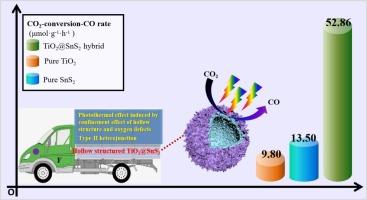Photothermal assisted CO2 photoreduction over hollow urchin-like structured TiO2@SnS2 heterojunction with enriched oxygen defects
IF 13.2
1区 工程技术
Q1 ENGINEERING, CHEMICAL
引用次数: 0
Abstract
Solar driving CO2 photoreduction represents a highly promising strategy that can not only reduce CO2 level in the atmosphere but also yield value-added chemicals. Herein, an urchin-like hollow structured hybrid with TiO2@SnS2 heterogeneous junction was designed and synthesized through a facile approach including hard-template method and hydrothermal process. When used as catalyst for photocatalytic CO2 reduction, the optimized sample exhibited exceptional activity with a CO yield rate of 52.86 µmol·g-1h−1 and durability during 4 cycles within 28 h. The enhanced performance could be attributed to i) the confinement effect of hollow structure enhancing the light capture and absorption owing to the multi-reflection/scattering of incident light in hollow cavity; ii) the constructed hetero-junction between TiO2 and SnS2 facilitating the transfer and separation of charge carriers and iii) photothermal effect induced by confinement effect of hollow structure through trapping the unused incident light and oxygen defects promoting the activation of CO2 molecules. We believed that this work could inspire further development in the field of synthesis of hollow structured catalysts as well as photocatalysis.


具有富氧缺陷的中空海胆样结构TiO2@SnS2异质结的光热辅助CO2光还原
太阳能驱动的二氧化碳光还原是一种非常有前途的策略,它不仅可以降低大气中的二氧化碳水平,还可以产生增值化学物质。本文采用硬模板法和水热法,设计并合成了一种具有TiO2@SnS2异质结的类海胆中空结构杂化物。当用作光催化CO2还原催化剂时,优化后的样品表现出优异的活性,CO产率为52.86 µmol·g-1h−1,并且在28 h内持续4次循环。由于入射光在空心腔内的多次反射/散射,空心结构的约束效应增强了光的捕获和吸收;ii) TiO2和SnS2之间构建的异质结促进了载流子的转移和分离;iii)空心结构的约束效应通过捕获未使用的入射光和氧缺陷引起的光热效应,促进了CO2分子的活化。我们相信这一工作将在空心结构催化剂的合成和光催化领域得到进一步的发展。
本文章由计算机程序翻译,如有差异,请以英文原文为准。
求助全文
约1分钟内获得全文
求助全文
来源期刊

Chemical Engineering Journal
工程技术-工程:化工
CiteScore
21.70
自引率
9.30%
发文量
6781
审稿时长
2.4 months
期刊介绍:
The Chemical Engineering Journal is an international research journal that invites contributions of original and novel fundamental research. It aims to provide an international platform for presenting original fundamental research, interpretative reviews, and discussions on new developments in chemical engineering. The journal welcomes papers that describe novel theory and its practical application, as well as those that demonstrate the transfer of techniques from other disciplines. It also welcomes reports on carefully conducted experimental work that is soundly interpreted. The main focus of the journal is on original and rigorous research results that have broad significance. The Catalysis section within the Chemical Engineering Journal focuses specifically on Experimental and Theoretical studies in the fields of heterogeneous catalysis, molecular catalysis, and biocatalysis. These studies have industrial impact on various sectors such as chemicals, energy, materials, foods, healthcare, and environmental protection.
 求助内容:
求助内容: 应助结果提醒方式:
应助结果提醒方式:


